What the jury didn’t know about wife killer Ian Riggs
Just four days after Ian Riggs killed his wife Patricia in their Margate home, and only a day after he reported her missing, he was already starting to erase her from his life. It set off her father’s cruel 18-year ordeal to get justice for his daughter.
Crime & Justice
Don't miss out on the headlines from Crime & Justice. Followed categories will be added to My News.
JUST four days after Ian Riggs killed his wife Patricia, and only a day after he reported her missing, he was already starting to erase her from his life.
Tricia Riggs’ father, Jon Knowles, went to his daughter’s Margate home the day after Riggs told him Tricia had disappeared, and was shocked by what he saw.
Riggs was there with family members and Knowles says the place was a hive of activity.
“He was getting rid of anything Trish had anything to do with,” Knowles says.
“I believe all her clothes had disappeared, her personal belongings had disappeared.
“They were taking down curtains and blinds that she’d put up.”
Jury returns in case of Ian Riggs charged with murder of wife Patricia
Patricia Riggs murder trial: Accused husband ‘trapped in a lie
Edmund Riggs pleads not guilty to murder of wife Patricia Riggs

Knowles says he was told most of Tricia’s clothes had been given to a charity shop.
“What struck me was, if you’d lost a dog you’d be out looking for it, but there was no activity to look for Trish,” he says.
In the days that followed, as Knowles went around local streets posting missing person flyers with Tricia’s mother, he asked Riggs what he was doing to find his daughter.
“He said ‘Oh, I’ve spoken to police, I’m too upset to do anything’,” Knowles says.
A few weeks later, when Knowles went to visit his four grandchildren at Riggs’ mother’s house, he was in for another shock.
Down a hall, in all the family photos Tricia was in, her face had been cut out.
Knowles, who had separated from Tricia’s mother, Carol Saxton, when his daughter was very young, had still been close to her, talking to her once a week.
When Riggs told him his daughter had walked out late on a Sunday night, taking just her mobile phone, credit card and keys, but leaving her wallet, he knew it did not add up.
Tricia home schooled the children, and the experienced swimming coach was due to start a new job as a swimming instructor the day after she was last seen.
She had also enrolled to do a university business management course.
“I rang her mother Carol and said ‘It stinks. I think Ian has murdered her. Get up here, because it’s serious’,” he says.
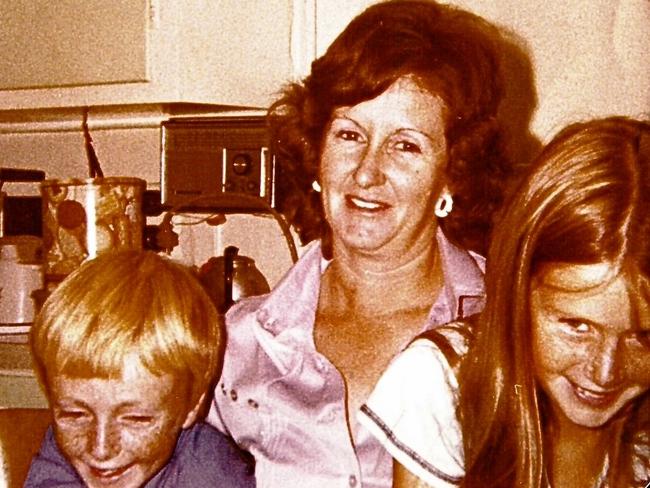
Tricia Riggs grew up in Queanbeyan in NSW with her mother and younger brother Mark Knowles, and Jon Knowles says in her mid-teens she was a drug-using “wild child”.
Her mother sent Tricia to live with Knowles in Lismore for about a year, and he says after a few rebellious episodes of sneaking out to see a boy, she straightened out.
When she returned to live with her mother in Canberra, they both became involved in a very insular Pentecostal church, and that’s where she met Ian Riggs.
A FATHER’S REGRET
Jon Knowles regrets the day he gave Tricia, then 17, permission to marry Riggs, who was eight years older than her.
“It was like a church-arranged situation, as far as I was concerned. She was under 18, so she needed my permission. I felt she was far too young,” he says.

After Tricia came to Lismore for a week, pleading with him to change his mind, Knowles said he gave in and was there to walk his daughter down the aisle in 1984.
Riggs killed Tricia on the day after their 17th wedding anniversary, leaving Matilda, 14, Harriet, 11, Ned, 9, and Macarthur, 7, without their mother.
Carol Saxton had been extremely close to her daughter and grandchildren before they moved from Canberra to Darwin in 1997, when Riggs got a mining job.
After he injured his hand and stopped working, the family moved back to Canberra, living with Carol and Bob Saxton for six months, before moving to Margate.
Soon after Tricia’s disappearance, Carol and Bob came to Margate to be with the grandchildren.
It was not until 15 days after Tricia’s disappearance that police were to search the home and declare it a crime scene, after finding blood spots on the couple’s bedroom wall.
NO TRACE
By that stage all the bedding from Ian and Tricia’s bedroom on the night she died was gone.
Riggs told the court he had washed the clothes he wore that night and wiped down the bed post where he said she hit her head, with disinfectant and water.
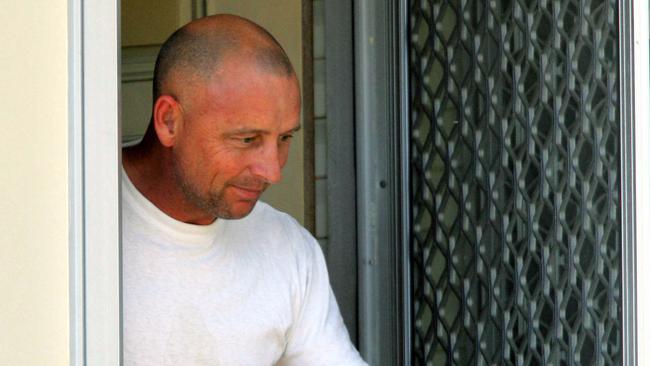
As police prepared to do forensic tests, Ian Riggs disappeared, catching a bus to northern NSW under an assumed name, leaving Tricia’s mother to look after his children.
“He left the children alone, without telling them where he was going or for how long,” Carol Saxton wrote in 2003.
“The children were absolutely distraught; first their mother goes missing and then their father.”
Riggs returned, 10 days later, the day after Carol took Ned and Matilda to Redcliffe police station, to be questioned about the last night they saw their mother.
A FAMILY DIVIDED
“He told Carol to get out. She tried to keep in contact with the kids, but he stopped her at every point,” Knowles says.
“One time he was going to Canberra with the children and he said to Carol ‘I’ll let you see them in a park’, and she went to give the kids Christmas presents.
“She mentioned something about their mother and he blew his stack, told the kids to get in the van and took off.
“She tried to see them in Brisbane on a couple of occasions, to give them birthday presents, but he threw them out the window.”
Several times over the years Carol and Bob would travel up from Canberra and go to the children’s schools — just to try to get a glimpse of them.
“It was very hard watching her go through all that,” Knowles says.
“It wasn’t just losing a daughter, it was losing your grandchildren, as well, and it was the same for me. You suddenly lose one and the next minute you’ve lost five.”

Knowles says that in the early days he tried to keep in with Riggs, so he could see his grandchildren, and try to find out what he knew of Tricia’s whereabouts.
The rule was he was not to mention Tricia during those visits.
“I never said I suspected he was the killer, because I was trying to access the kids and access him,” he says.
“He never let the kids out of sight with me.”
Knowles says he would feed Riggs “garbage”, telling him police were searching a local swamp or a new estate, just to see if he could get a reaction.
Riggs insisted Knowles contact him only on his mobile number to arrange to see the grandchildren, but before too long he also was cut off.
“In the end he stopped answering the phone or changed the number, and I could never get him,” he says.
At one stage Riggs went to court to try to get a domestic violence order against Carol Saxton, to keep her away from her grandchildren, but was unsuccessful. A year after Tricia went missing her mother held a memorial service for her in Canberra, but Knowles did not attend.
“Even though I knew in my heart of hearts that she was dead, I couldn’t let go of that little percentage that she was alive,” he says.
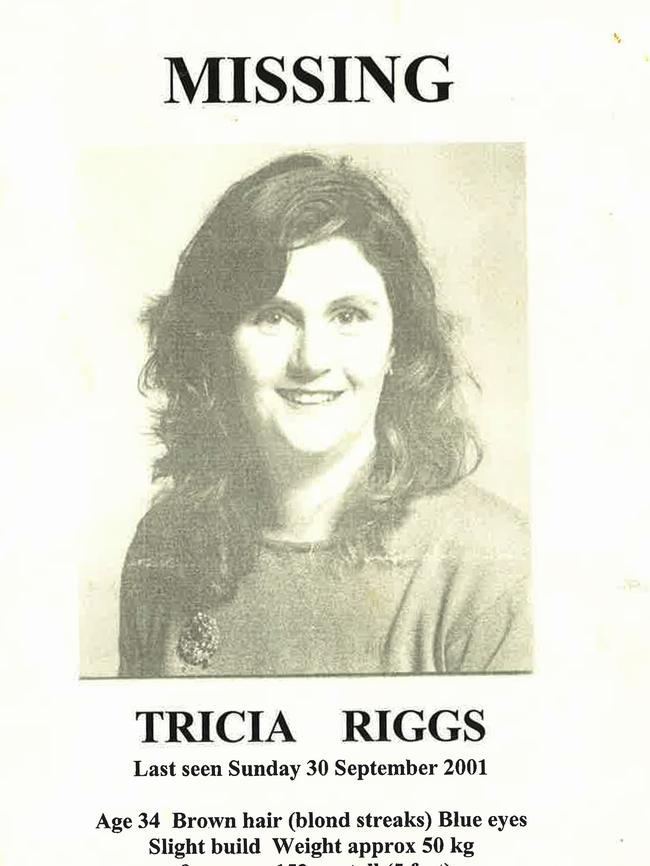
Over the years Knowles encouraged media to write about Tricia’s disappearance and he put up new posters, trying to find anyone who saw something on that fateful night.
He met with the Police Minister and Police Commissioner, persuading them to offer a $100,000 reward for information leading to conviction of the responsible person.
When Knowles found out that Riggs had sold the Margate home he saw it as an opportunity for police to do a ground penetrating radar inspection of the laundry, where he suspected Tricia could be buried.
There had been a leak in the laundry and it had been dug up before Tricia went missing.
“I went and saw the new owners and laid it all out,” Knowles says.
“When I knocked on the door I said to the wife ‘You don’t know me, my name’s Jon Knowles. I’m going to shock you. I believe my daughter was murdered and could be buried here, under the laundry floor. Would you give permission for police to do ground radar, through the concrete?’,” Knowles says.
“They were looking at me as if I was something out of the moon.”
The next day the owners told him they gave permission and in 2013 the ground penetrating radar was used in the laundry, but nothing was found.
It was not used in the backyard, where Tricia’s remains had been reburied by Riggs, and it would be another three years before they were found.
BACKYARD DISCOVERY
When Knowles heard his daughter’s bones were in the backyard of Riggs’ former Margate home, which he sold in 2007, he felt great relief.
“Relief that he’d been arrested, because I found out both at the same time,” he says.
“They’d found her, so it was a great relief, because the one thing you want to do is be able to lay your child to rest.”
When Riggs was arrested, his car had the number plate “BODIES”.
Sadly, his arrest came too late for Carol, who died in 2011 from leukaemia at age 65, without finding out what happened to Tricia, her first child.
Mark Knowles says his mother and Tricia had been incredibly close, like best friends, and her daughter’s loss and being cut off from her grandchildren devastated her.
“She was never the same person. It just broke her,” he says.
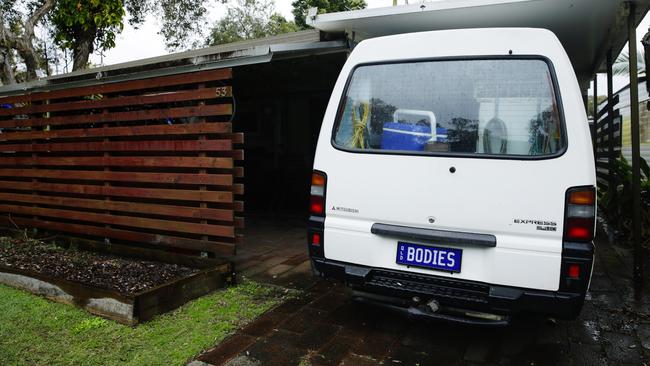
For Jon Knowles, 74, the worst part was not knowing where his daughter was.
“The whole 15 years, not knowing where she is, not sure if she’s in a swamp or dug under the ground or just lying somewhere, you’ve got no idea what’s going on,” he says.
Finally, Tricia’s family and friends were able to have a funeral in Canberra and put her ashes in a lawn cemetery wall, next to her mother’s.
Knowles still keeps some of his daughter’s ashes next to his bed, beside those of his son, who died in a motorcycle accident eight years ago.
Riggs could not explain in court why he sold the Margate house, leaving Tricia’s remains buried there.
“It surprised me she’d been moved there. If you got away with something for years, why would you go and move it, why would you disturb it?,” Knowles says.
He thinks Riggs must have been desperate for money.
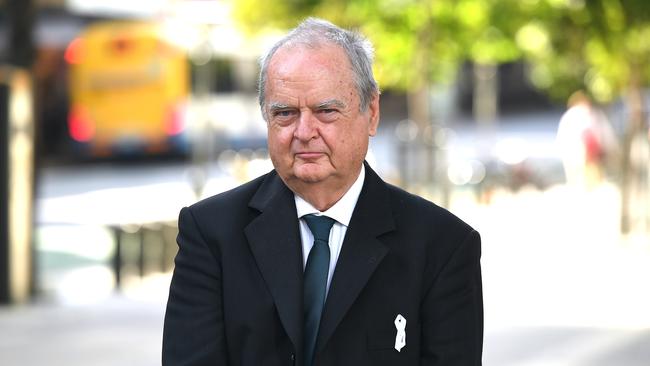
In 2002, Riggs forged Tricia’s signature on a document transferring a car to his name.
In 2007, Riggs tried to get Tricia declared dead, so he could sell two other properties in both their names, but dropped the application when her parents were set to oppose it.
Two years later Matilda had her mother declared dead and the properties were then sold.
Riggs had injured his hand in a mining accident in the Northern Territory and got a $122,000 payout, some of which he used to buy the Margate house in his name only.
He had barely worked since then and for a long time Tricia, an accomplished swimming instructor in Darwin and Canberra, had been the breadwinner.
BROKEN MARRIAGE
The marriage was well and truly rocky before the family moved to Margate, and was only held together for the kids.

Riggs says that on the night he killed her she had told him she’d found a list of escorts in his pocket and had told him of her own sexual affairs.
Tricia had told Riggs’ sister she was going to seek full custody of the children and “screw” Riggs for everything.
“Tricia was a very loving girl and a very determined girl,” Knowles says.
“She basically kept that family together most of the years because Ian would get good jobs, work for them for about three months and give them away. He just liked to live off welfare.”
Last Thursday Jon Knowles sat in the front row of the Supreme Court gallery, staring at Riggs as he calmly and with no emotion told how he accidentally killed Tricia.
As Knowles sat in the courtroom with son Mark, other family and friends — his grandchildren, who were supporting their father, sat on the other side of the room.
“I hope I can still have a relationship with them. Trish was an extremely good mother to them and she and Carol would want me to do that,” Knowles said.


